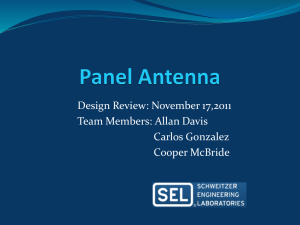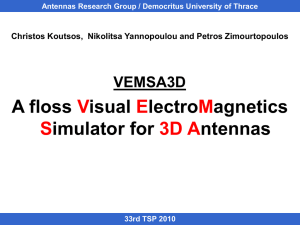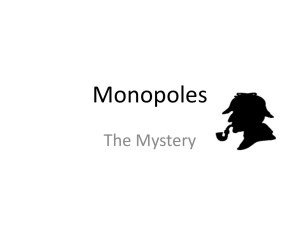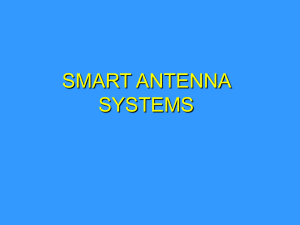Slides - Faculty of Science and Engineering
advertisement
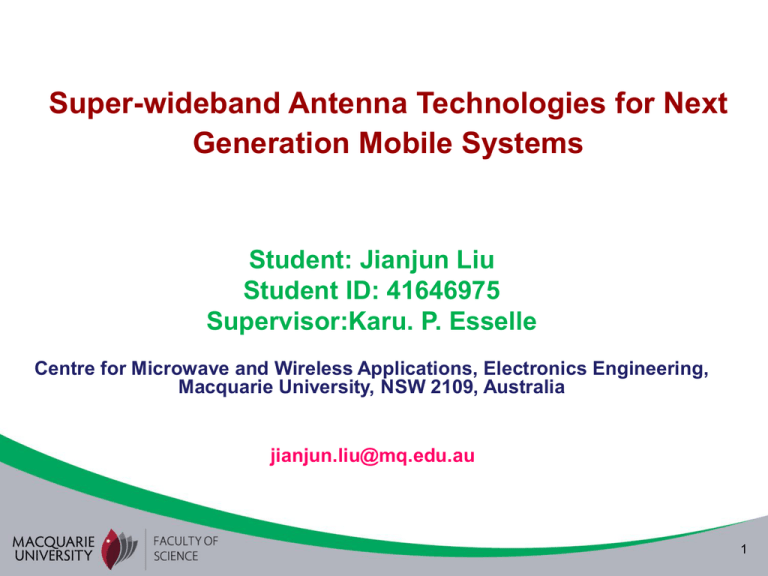
Super-wideband Antenna Technologies for Next Generation Mobile Systems Student: Jianjun Liu Student ID: 41646975 Supervisor:Karu. P. Esselle Centre for Microwave and Wireless Applications, Electronics Engineering, Macquarie University, NSW 2109, Australia jianjun.liu@mq.edu.au 1 Outline • Introduction • Antenna requirement • Antenna development and Case study • Proposed extremely wideband antenna for wireless communication Systems • Conclusion 2 Wireless Communication System -41.3 dBm/MHz maximum power level for UWB 3 Examples for existing communication standard • • • • • • • • GPS (1.57–1.58 GHz) WCDMA (1.92–2.17 GHz) Bluetooth (2.4-2.48GHz) WLAN 802.11b/g (5.15-5.825) WLAN802.11b/g (2.4-2.4835) Wi-max (3.3-3.6GHz) Commercial UWB (3.1–10.6 GHz) Vehicle UWB radar system(22-29GHz) 4 Examples for multi-band wireless system Cellar system (GSM, Bluetooth, CDMA, USMT) 5 Wireless Local Area Network 6 • UWB through wall image operation (0-960MHz) • Commercial UWB, localization precision(3.1–10.6 GHz) • vehicle UWB radar system(22-29GHz) 7 Antenna Requirement • Key component • Antenna performance Proposal A: multiple antennas are implemented Each one covers a specific operation spectrum. Disadvantage: • Occupy much space for other device • Increase the system complexity. • The installation may restrict the system updating possibility after manufacture. Proposal B: Utilize single antenna • Antenna bandwidth can cover more than one operating frequency bands of multiple wireless communication systems • Such antenna should have stable radiation-pattern characteristics over entire frequency range. 8 Antenna Development Lodge’s biconical antennas (1898) Carter’s improved match biconical antennas (1939) The antennas are bulky and too heavy for portable device 9 Equiangular spiral antenna (1959) log-periodic dipole antenna (1960) The movement of the effective radiating region with frequency results in waveform distortion of a transmitted pulse 10 Metal-plate Monopole Antennas Ratio impedance bandwidth: 13:1 Frequency range :0.8-10.5GHz J.A. Evans and M.J. Ammann. “Planar trapezoidal and pentagonal monopoles with impedance bandwidths in excess of 10:1 [C],” IEEE Antennas Propagat. Symp., vol.3, pp. 1558-1561, July, 1999. 11 Frequency range :1.38-11.45GHz Ratio Impedance bandwidth: 8.3:1 Kin-Lu Wong, Chih-Hsien Wu, and Saou-Wen Su, “Ultrawide-Band Square Planar Metal-Plate Monopole Antenna With a Trident-Shaped Feeding Strip, ” IEEE Trans. Antennas Propagation, vol.53, pp1262-1269, April, 2005. The perpendicular ground plane leads to antennas with high profiles which is inconvenience for integrating with monolithic microwave integrated circuits (MMIC). 12 Microstrip-feed Printed Monopole Antenna Impedance bandwidth ratio : 3.52:1 Frequency range :2.78-9.78GHz J. Liang, Choo C. Chiau, X.D. Chen, et al. “Study of a Printed Circular Disc Monopole Antenna for UWB Systems” [J].IEEE Trans. Antennas Propag., 2005, 53(11):3550-3554. 13 CPW-fed Printed Monopole Antennas Impedance bandwidth ratio : 4.4:1 Frequency range : 2.73-12GHz J. Liang, L. Guo, C.C. Chiau, X. Chen and C.G. Parini. Study of CPW-fed circular discmonopole antenna for ultra wideband applications[J].IEE Proc.-Microw. Antennas Propag.,2005,152(6):520-526. 14 Complanation Transform from Discone Antenna Disc Discone Coaxial-feeding line Elliptical patch Trapezoid ground plane CPW feeding line 15 Performance for antenna with Trapezoid Ground Plane a Dmin b wtop A t z x y H G Tapered strip wbottom B Dmax S.-S. Zhong, X.-L. Liang and W. Wang, “Compact elliptical monopole antenna with impedance bandwidth in excess of 21:1,”IEEE Trans. Antennas Propagation, vol.55, pp. 3080-3085, November, 2007. 16 Performance Comparison between different printed antenna tapered BWNo.2 10.7 1.7 BWNo.1 6.3 trapeziform BWNo.4 11.6 1.6 BWNo.3 7.2 Elliptical BWNo.6 21.6 2 BWNo.4 11.6 17 Characteristic Mode Analysis for Printed Antenna (a) (b) (c) K. D. Akkerman, T. F. Kennedy, S. A. Long, and J. T. Williams, "Characteristic modes for planar structure feed design," in Antennas and Propagation Society International Symposium, 2005 IEEE, 2005, pp. 503-506 vol. 2B. 18 Characteristic Mode Analysis for Printed Antenna 19 a Dmin b wtop A t z x y H G Tapered strip wbottom B Dmax 20 Modified Coplanar waveguide-fed elliptical monopole The feeding terminal affect the high frequency impedance matching 21 Modified Coplanar waveguide-fed elliptical monopole With height and width of patch increased, the lowest limit decrease and ratio bandwidth increase Width a(mm) b=30mm a=30 a=120 Ratio bandwidth VSWR≤2 Impedance bandwidth (GHz) VSWR≤2 25.5:1 0.98 - 25 53:1 0.47-25 Ratio bandwidth VSWR≤2 Impedance bandwidth (GHz) VSWR≤2 b=30 53:1 0.47-25 b=90 64:1 0.39-25 Height b(mm) a=120mm 22 Modified Coplanar waveguide-fed elliptical monopole Gap is a crucial parameter, The gap variation will affect the impedance bandwidth of whole spectrum 23 Modified Coplanar waveguide-fed elliptical monopole Substrate: Rogers permitivity:3.48, thickness:1.5mm。 a b H Dmax Measured bandwidth: 1.02-24.1 GHz, ratio bandwidth:23:1 24 Modified Coplanar waveguide-fed elliptical monopole (a) Maximum gain: 7.2dB Gain decrease:1 substrate loss 2 radiation shifting Smith chart (b) (c) (d) (a) f=1.5GHz (b) f=5GHz (c) f=10GHz (d) f=20GHz With the frequency increasing, cross polarization increased. Reverse current lead to pattern distortion and horizontal current lead to cross polarization enhanced. 25 Modified Microstrip-fed printed monopole Based on modified CPW-fed printed monopole, two modified microstrip-fed monopole are proposed 26 Modified Microstrip-fed printed monopole Ratio bandwidth VSWR≤2 bandwidth (GHz) VSWR≤2 Ordinary antenna 20:1 0.47 – 9.8 Proposed antenna 59:1 0.47-28 Antenna type 27 Modified Microstrip-fed printed monopole Top side Measured bandwidth: 1.08-27.4 GHz, ratio bandwidth:25:1 Back side 28 Modified Microstrip-fed printed monopole E Plane H Plane E Plane H Plane (a) f=1.5GHz (b) f=5GHz (c) f=10GHz (b) (d) f=15GHz(e) f=20GHz 29 Modified Microstrip-fed printed monopole Maximum gain: 6.5 dB Gain variation between 4-20 GHz: 2.5 Db 30 Modified Microstrip-fed printed monopole Original proposed antenna Measured bandwidth: 0.85-25 GHz 31 Modified Microstrip-fed printed monopole ordinary tapered proposed 2.3-8.1 0.82-8.15 0.82-25 Ratio bandwidth 3.5 9.2 30.5 Input impedance (Ω) 18 - 145 22-115 40-79 Bandwidth (GHz) VSWR≤2 32 Modified Microstrip-fed printed monopole Top side Measured bandwidth: 0.76-35.2 GHz, ratio bandwidth:46:1 Back side 33 Modified Microstrip-fed printed monopole E Plane H Plane E Plane H Plane (a) f=1.5GHz (b) f=5GHz (c) f=10GHz (b) (d) f=15GHz(e) f=20GHz Radiation shifting is small 34 Modified Microstrip-fed printed monopole Maximum gain: 8.3dB, gain increases in the whole spectrum 35 Conclusion • Three new configuration of monopole antenna for wireless applications • Four Techniques can enhance BW: 1 tapered Microstrip-feeding line 2 trapezoid ground plane 3 optimized radiation patch 4 semicircular feeding branch terminal 36 37


